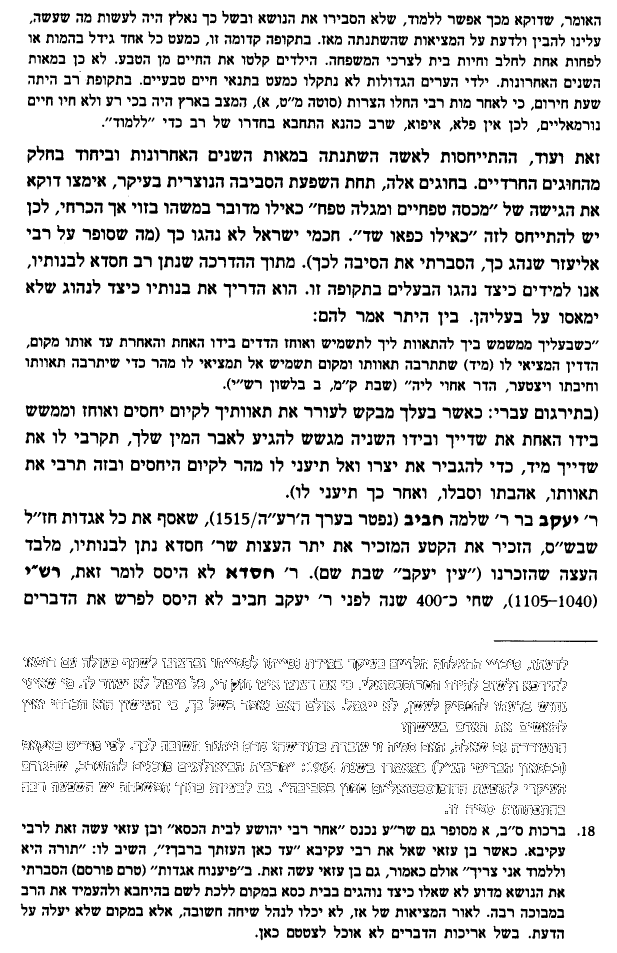(By the way, the article also tells how "On [R.'s] wedding night, her brand-new husband called her into the living room, where a large picture of the Admor of Gur - the rabbinic leader of that Hasidic sect - hung on the wall. He told her she had to imagine the rebbe's face when she observed the mitzvah of ishut (conjugal relations), so that she would have "righteous" children". I'm not sure, but isn't this a problem of one of the Benei Tesha Midot, namely, Benei Temura? See BT Nedarim 20b. On the other hand, see BT Brakhot 20a where the Talmud relates that "R. Yohanan was accustomed to go and sit at the gates of the bathing place (- mikvah). He said: When the daughters of Israel come up from bathing they look at me and they have children as handsome as I am." Vezarikh Iyun.)
But is this attitude unique to the Gur Hasidut? While this may be the case today, it wasn't this way in the previous century. The following comes from R. Avraham Korman's "Ha'adam Vetivo" (Tel Aviv 5763, pp. 253-256), where he retells several stories which took place in pre-war Europe (I marked them with a red border) and as it seems from these stories, the Gur attitude was far more widespread then, at least in Hasidic circles, something that has definitely changed nowadays.
Not surprisingly though, going back to the 18th century we see this attitude was prevalent even in the general Jewish population and it wasn't limited as it were, to hasidim. An example of this is found in the autobiography of Solomon Maimon. While writing about the Polish Jews of the time, he describes their innocence and naïveté:
I will only add that Maimon's theory about being separated after menstruating will bring a couple closer to each other is actually sourced in BT Niddah 31b where it says "It was taught: R. Meir used to say, Why did the Torah ordain that the uncleanness of menstruation should continue for seven days? Because being in constant contact with his wife [a husband might] develop a loathing towards her. The Torah, therefore, ordained: Let her be unclean for seven days in order that she shall be beloved by her husband as at the time of her first entry into the bridal chamber."





Great post. Very interesting.
ReplyDeleteGood question from the Gemara in Nedarim. I suppose one could answer that the issue there is having lascivious thoughts of another person, something which they may believe won't occur with regard to the rebbe.
Even if you don't like this pshat, the Gemara in Berachos can be answered up by saying that R. Yochanan wasn't at all saying that they should think of him, but simply that there is a segulah for a woman to see a good thing when she walks out of the mikvah. See YD 198 at the end and also the Atzei Levona there (http://hebrewbooks.org/pdfpager.aspx?req=9146&st=&pgnum=336&hilite=).
Oh, and good catch from the Gemara in Niddah about the separation theory. I've thought for a while now that quite a few of the reasons for certain mitzvos which a lot of people think are just apologies to have the Torah accord with more modern sensibilities, are in fact straight up Gemaras, and this is a classic example.
I did not read the Ha'aretz article, nor did I read the one succeeding it, all I noticed was your question about "ha'hu chassid" so don’t hate the player im lo kach hava ha’hi maaseh. [With all due respect, it's not worth your time fahrenfering such stories so that it shtims with halacha etc.] as a question in itself from the gem. in Berachos to the gem. in Nedarim yesh l'yashev:
ReplyDeleteThe 'bnei tmurah' are specifically speaking of when the man has thoughts of an 'erva', (Tur OC 240, see also the Birkei Yosef there in the name of the Raava"d - http://www.hebrewbooks.org/pdfpager.aspx?req=7626&st=&pgnum=123). However R. Yochanan's intent was to act as a neutralizer for the woman's thoughts so that her mind not be defiled by anything of impure nature at the time of conception, and on the contrary, his image would be a positive effect on the child's spirituality. This practice is mentioned in the Rema YD 198; the mekor being from the Rokeach [based on a medrash], who specifically alludes to the gem. with R. Yochanan (http://www.hebrewbooks.org/pdfpager.aspx?req=15280&pgnum=232).
Interesting to note, in a certain mikvah in Djerba the community hung a picture of R. ZM Mazuz (it's brought in the short bio. printed in his sefer 'Shaarei Moshe' - the new ed. not the one on hebrewbooks) so the woman would gaze upon his image after coming up from the mikvah. This is also advised by many as a segula for pure thought in general, particularly to be placed in a bedroom.
The Kotzker vort was inspiring [and enlightening] as always. Thanks.
This is greatt
ReplyDelete